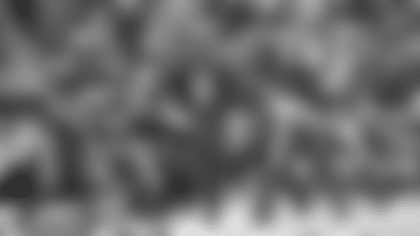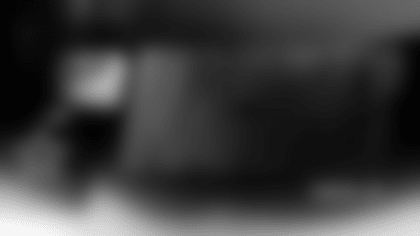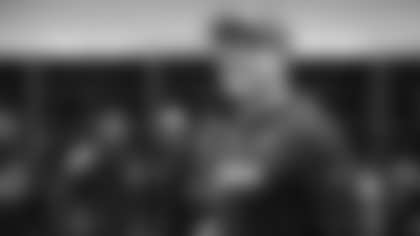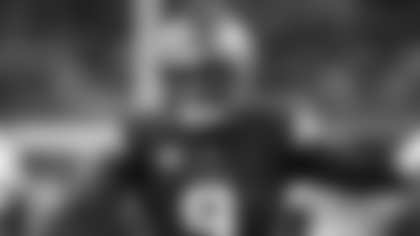Vikings General Manager Rick Spielman
First off, I wanted to start and thank everybody that's associated with this process. Jamaal Stephenson, our director of college scouting, this was his second year and has done an outstanding job of setting up the logistics and running our meetings; coordinating everything. Coach Zimmer, the coaching staff, and the work and time they've put into this process. It's a great working relationship between our coaches and our scouting department. Tony Sparano and Pat Shurmur did an outstanding job and added a lot of new and different thought processes to what we were looking for at specific positions. Scott Kuhn, who is kind of leading our charge in analytics, he took us up another notch this year and some of the ideas and how we apply the analytics to our draft process. Eric Sugarman and our doctors for all of the time and effort they put into this. The whole support staff and all of our consultants - I think when I sat back there and added it up, we'd be here for an hour if I added everyone, but we had close to 100 people in some way, shape or form that put their hands or touch on our draft process as we go through this. There's a lot of people that put a lot of hard work into it to try and help us make the best possible decisions.
It's an exciting time of the year. This, to me, is always the last chance that you get to add to your roster from a personnel stand point that can potentially have an impact on your team going forward. It's the foundation of our football team. The process of continuing to layer in another draft class to what we currently have and what we were able to accomplish over the last couple of years. When we do this, we're not only looking at the short-term and what can help us next year, but we also have to look at the long-term. When I sit there and look at our roster and start to shape what our roster is going to look like in '16, but also I have to have an eye on what we're going to look like in '17 and '18. You always have to have in mind potential guys that are going to be out of contract. If these draft kids that we bring in here, are they going to be potential players down the road for us and may have to sit a year?
The one thing that I can truly say, and I've been doing this for 26 years now, is that I've never been around a coaching staff, led by Coach Zimmer and his staff, on developing young talent. I think that's becoming pretty clear and evident to the media and to the fans on taking specific guys that fit the Minnesota Vikings. We are very in-tune to what we want and it may not be a fit for other teams, you could see us pass by guys and say, 'Why would they pass by him? He's a good football player.' Or we may take a name that may not be familiar to you and say, 'Why the heck would they pick that guy?' But truly, I really believe in the process that we go though, the traits that we're looking for and the system fit that these coaches want when we bring in these players. We have a specific criteria and our draft board gets narrowed down to specific areas in each round and there's only certain players that are going to fit what we want as a Minnesota Viking.
We were very active in the offseason, I think we ended signing 13 of our own players, plus our seven practice squad guys to put it up to 20 and six unrestricted free agents. By doing that, I believe it gave us a lot of flexibility going into this draft. As I sit there and enjoy reading the mock drafts and everybody out there trying to determine what we're going to do, we are in a position to take the best player, I'm sure I'll get a receiver question here, I'm not sure, but in case someone does; we're not honed in on a receiver in the 1st Round. We'll look at the potential best available player regardless of position. I think that's the way that we have done it and will continue to do that because it ends up paying off for you. Not only for potentially this year, but as we go into the future years.
Q: How did you go about incorporating Pat Shurmur and Tony Sparano and what did they bring to the table that was different?
A: A couple of things, I think both of them with their knowledge, with their experience in the league, with the traits they're looking for at their positions. I always ask anytime we bring in a new coach, or we bring in a new scout, what did you do you at other places? Look at our process, is there things that we can always add to make us better in the process we go through as we get ready for the draft. They had some different ideas, but I know coming out of those meetings and as we talked about the players, I can truly tell you what type of player was appealing to them and what type of player wasn't. There was no grey area with those guys, which I really appreciate. Us as a scouting department, or me personally, may not totally agree with them, but I know where they stand and that's the most important thing.
Q: How do the players the two new coaches wants mesh with those of Norv Turner?
A: Our coordinators, when we're in offense, Norv [Turner] is in there with the whole offensive side of the ball as we bring in each individual coach and the same thing with George Edwards on the defensive side of the ball. I know as they're sitting and they're going through their offseason and from a coaching and schemes and what they're going to do differently or what they're looking for. Usually by the time we come into the draft and get ready for that, they know what they're going to do and that gives us a better understanding of the type of players that they're going fit in to the things they're trying to get accomplished.
Q: How is Coach Norv Turner adjusting to the different inputs?
A: I'm not sitting in the offensive meeting rooms, so I know [Head Coach Mike Zimmer] Zim may be. I know just from my experience and those guys meshing together in our draft process, it was great. It really was.* *
Q: What is the depth of the wide receivers overall in this draft? It seems like there might be some good options in the 2nd and 3rd rounds?
A: Even a Stefon Diggs in the 5th, I don't know how the draft is going to fall. Like I said, we spent a lot of time at all of these positions, but I do think there is a lot of quality at that position as you go down through. There's different styles, different types: small ones, tall ones. I mentioned earlier, we don't look so much at the height, per se, as the catching radius. There's fast guys, there's possession guys. There's a lot of different flavors. We know after sitting and going through that position in particular, what guys we identify that we think would be a good fit here. Where Teddy [Bridgewater] is as a quarterback, but I also don't want to discount our current receivers that we have on this roster. Charles Johnson did a great job two years ago; unfortunately he got injured and never got back into the picture and Stefon. I know Cordarrelle Patterson has worked extremely hard this offseason and I know everybody is excited to see him when we get out on the field here in a couple of weeks. Adam Thielen is a great 3rd or 4th type that fills in and plays on special teams. Jarius Wright, we feel is very, very comparable in the slot. We have a lot of young guys that are still developing and we're hoping that will continue to grow with our young quarterback.
Q: You've often said you want 10 selections each draft, is that still the case when you're not a rebuilding team anymore?
A: I kind of take the approach that we're starting fresh. That way your mind is not skewed one way or another and you're just focused on - let's get the best football players we can get and if we can get those guys in here, the coach will figure out how to use them and how they carve out their roles and go from there. I don't ever say, 'Because we had success last year, or because we were so active in signing all of these guys that we're not going to take a player.' Because that might not be an immediate need that people see as of today, but it sure in the heck could be a huge need that we could fill this year for potentially next year, as well. I'm always going to take the approach, I don't worry about that as much as much as I worry about just getting the best football players we can get in here.
Q: What traits are you looking for at safety next to Harrison Smith and is it tough to evaluate these prospects given they're defending spread offenses in college?
A: There's a couple of safeties, but I think what most teams are doing now is looking at these big corners and trying see if they can convert to a free safety. Harrison Smith, can do things at the line of scrimmage very well, he plays the backend very well. I know from a philosophy standpoint, we are looking for safeties that are interchangeable, they have to be able to do both. It's not just one playing strong up to the line of scrimmage and the other one playing back free all of the time. As we look at these safeties, we're looking can they do the things we do from a defensive standpoint and can they be just effective close to the line of scrimmage as they can be on the backend.
Q: In the interim, could Michael Griffin be interchangeable with Harrison Smith at the other safety spot as well?
A: That's why we signed him. But we're going to see. He's learning a new system. I know one of the reasons he came here was because he knew the coaching that he was going to get here and the history of this coaching staff in taking some of these vets and recreating them. I think that will all play out as we go through here once we start to get on the field and start to see how things start to fit together.
Q: Can you describe the process of thinking that goes into what you do after the 1st round in that 24 hours up to the 2nd round?
A: I still wish the thing would go for three rounds in a row, but that's another point. It'll be interesting at the 23rd pick because I've already had two calls that I can verify today about teams potentially coming up our way. And one potentially may be in the 2nd round, so we're going to have to make some determinations and usually those decisions aren't made until we're actually on the clock. One, who's available there? Is he too good to pass up? Two, what is the depth behind that position if we do pass him up? Do we have another swing at a guy we like at that same position potentially in the 2nd round? Or three, don't move out of the 1st round because of that fifth year option. Maybe try to move down within the 1st round and still get a player that you feel very excited to get.
Q: Did you have any interest in Josh Norman on the open market last week?
A: Right now, from where we're at a cap standpoint and where we feel our teams is, I won't comment on [him] because he's now a Washington Redskin, I believe. But he's a very good corner. I know we have some big bills to pay coming down the road here with some of our young guys, so I want to make sure and I always make sure that our players come first that we feel very strongly about them.
Q: Is there absolutely any position you will not address in the draft this week?
A: No. Every position will be open in the draft. There's not one position we will not look at in the draft. In general, we will keep the blinders wide open.
Q: Are you including kicker and punter in that conversation?
A: I am including everybody.
Q: Are you going to use more analytics this draft?
A: It's used as a tool and for example – I won't get into specifics because I think there's a lot of trade secrets and a lot of things that we do differently and how we approach the analytics. The one thing I know where analytics has come into the fact is I know you guys look at the value charts on trades. We don't use those at all. We look at the analytics on, "Ok, slot number 16 and slot number 34: is there a difference in the value of player you are getting there? Do you still have a chance to get a red starter at the 29th pick the same as you do with the 16th pick?" So there are what I call sweet spots on our draft board each round where we see value and if you get below that sweet spot, maybe the value decreases on the type of player you could potentially get. So we're not so honed into, "Well, we were 300 points short on here," or "we won by 200 points." The fact is we're looking at historically over since 1998, we look at the positions where starters have come out of the 3rd round, starters have come out of the 5th round. So if you have a position, for example, that 98% of the starters only come out of the first two rounds and you have another position that is stacked with that guy in the 1st round but you also say there's been other guys over the history that you've gotten in the 4th and 5th round that became just as good of players, then you balance that.
Q: Do you have the percentage of starters that come out of the 1st round?
A: Oh, yeah. I have percentage starters from first pick to the last pick in the 7th round.
Q: Can you elaborate on those numbers?
A: No. Our guys, Scott Kuhn and his crew do an unbelievable amount of work to come up with all of those stats and data, and to go through the thousands and thousands of players and to come up with percentages, those are things that I would just keep to ourselves.
Q: Did you ask Teddy Bridgewater for his input on some of these wide receivers in the draft?
A: Usually, it's funny when you walk through the locker room now, especially at this time of year. But most of the time if we go talk to a player, it's usually about one of his teammates or someone that he had played with or had an association with in the past and not so much – I'm not going to trust a player to tell me on his evaluation on a player. I've got plenty of guys that get paid to do that that do it for a living. But it's great to kind of hear the background and the insight of what he was as a teammate. Would he fit into our locker room and to our culture? So if I do or any of our coaches talk about some of the players that have been associated with some of the current guys on our roster, most of the time it's just going to be dealing with personality and some of the Viking traits that we're looking for.
Q: What are some of those traits and characteristics that you're looking for in a player?
A: I know Zim [Coach Zimmer] has talked to you about smart, tough and passionate players, disciplined player. We almost came up with 32 different traits rated from 1 to 32 at each position and there's a top five trait at each position and that's including everything from our alert checks to our psychological scores to our medical scores to their mental quickness scores to their combative attitude to their coachability, that's just things layered on top of the traits that we're looking for. But each position has different traits, but I don't ever want to get it confused with utilizing all of these things that we're doing and trying to get through it all. It's always going to come down to your gut instinct, it's going to come down to what they are as football players. That's the number one priority. And with all this other stuff coming availability, sports science, which we're all believers in, but you use it as a tool. You don't use it as a decision.
Q: Is wide receiver one of the more tricky decisions to draft since a lot of 1st rounders haven't panned out?
A: There's a history there. There's some really good receivers that panned out in the 1st round, too. I don't think it's any different than any other position to be honest with you. Some things you can't predict that are going to happen. But I don't think it's any less predictable than any other position.
Q: How do you get everybody to agree on 32 different traits?
A: Our guys are about ready for a break.
Q: So you rank 32 different categories?
A: It's more than that to be honest with you. I don't even want to get into mind boggling things that we do. It's actually over 100 different categories that we narrowed down to 32 that we narrowed down to 5 that are used as a tool, not as the decision process.
Q: When you say use a tool, is the number one priority still on the football field and you just use the traits as a sort of tiebreaker?
A: Correct. And that's including tying in our medical grades. That's taking everything that we do and putting it all together into one giant algorithm or many different algorithms, spinning them out and coming up with, "This is what this says. This is what we see as a football player. Ok, you make a decision with what you want to do."
Q: Is it more challenging on draft day when you are closer to winning and just a few players away but still need to keep in mind building for the future?
A: No, I think that's a little bit of a challenge. You are worried about '16, don't take me wrong, but you also are looking into the future but on the mindset, "Who's the best football player?" And if he helps you starter day one, if he helps you somewhere at one point there in his rookie year, if he helps you not until his second year, who's the best football player that you think you're going to take? And that's the approach that we have taken. Let's get the good football players and let it work itself out.
Q: Did the calls you receive both request coming up from the 2nd round or how did that go?
A: One was 1st round to 1st round, one was 2nd round to 1st round.
Q: Were they asking for your 23rd pick specifically?
A: They've called specifically not to say hello and stuff. They're asking about my 23rd pick.
Q: Were you intrigued?
A: I'm always intrigued. I'm intrigued in the 2nd round, I'm intrigued in the 3rd, 4th, 5th, 6th round. Usually you can't trade in the 7th.














